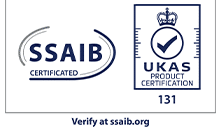10 Proven Ways to Protect Against Bicycle Theft
No matter how long they have been riding, every cyclist has one thing in common – the fear of bicycle theft. Whether you rely on your bicycle as your main mode of transport or are a hobbyist cycler, bicycle theft can be an incredibly frustrating and upsetting experience.
At Lincs Alarms, we offer a wide range of security measures, complete with professional installation and maintenance, which can be used to offer peace of mind when it comes to storing your beloved bicycle and protecting your assets at home or work.
As well as hiring professional services, there are other ways you can prevent bicycle theft and keep your two-wheeler safe in any location. In this guide, we are sharing the ten most effective, steps to prevent your bike from being stolen.
Locking Up
When leaving your bicycle for the day, make sure that you are locking the whole thing, by securing the frame and both wheels. This will make it difficult to move once you lock it in place and prevent bicycle theft.
If you are in public, secure both areas of the bicycle to a durable bike stand to prevent it from being moved and make it difficult for any opportunistic thief to take advantage of the situation.
Double Lock
Whether you have parked up outside the office or are leaving your bicycle in the garage until your next adventure, make sure you are double-locking it. Double locking is a great tool for protecting all kinds of vehicles and assets and prevents bicycle theft.
Using two locks on your bicycle can slow thieves down. The visible signs of these locks can also act as a deterrent, as thieves know they are not going to get away with the job easily.
For the best protection, use high-quality locks and make sure that at least one of the locks on your bicycle is a D-lock because these can offer higher levels of protection.
Secure Bicycle Parking
Where you leave your bicycle is just as important as the locks you use, so make sure you are considering this carefully. While bike stands are widely available in most public places, they are not always located securely.
Your bike should be stored and secured in well-lit areas that have CCTV in the area to make sure your bike is being monitored and prevent bicycle theft.
CCTV not only plays a crucial role in identifying thieves if the worst should happen, but in many cases, the mere presence of security cameras is an effective deterrent and will keep your bicycle safe in these areas.
Tight Fit
Public bike stands can be a great tool to prevent bike theft – if you take additional steps to secure your bicycle in place. As they are usually metallic, bike stands are incredibly durable and you can use this strength to your advantage by securing your bike as close to the stand as possible using locks and wires.
Opportunistic bike thieves will spend time around bike stands to see which ones can be easily removed and closely securing your bike to the stand actively prevents any possible manoeuvring from thieves.
Take Any Removable Parts
Bike thieves don’t necessarily have to take your whole bicycle to cause issues with their crime, as many will take anything that can be easily removed to try to make quick money.
Whenever you park up, take the time to collect any removable parts from your bike and carry them with you if possible. Items like lights, baskets, and even the saddle can be easily carried in a bag and kept on your person throughout the day to prevent them from being stolen.
Larger parts like the wheels can be additionally protected using locking screws or nuts. These lock the wheels or other removable parts in place and secure them to the rest of the frame to make them more difficult to separate.
Easy Identification
Security marking is an effective protection against bicycle theft, as it allows you to easily recover your bike should it be taken away.
These markings are a way to show that your bike has been registered and therefore will be easily identified as stolen, forcing thieves to think twice about taking it from you as they are more likely to be caught and arrested.
Verify Ownership
If you are investing in a new bicycle, take some time to verify the ownership to avoid buying stolen goods.
You can ask the buyer for proof of ownership, such as a receipt of the original purchase if buying secondhand, and use the frame number to check national databases to make sure it is not a stolen bicycle.
When checking frame numbers or registering a new one, ensure you are using databases that are approved by Secured By Design, as these are used by local authorities.
Register
Registering your bike means that should the worst happen, despite your efforts to prevent bicycle theft, it can easily be identified as such and find its way back to you.
Cyclists should register their frame number to a national bike registration database. There are several major options for bike databases, but ensure you are choosing ones approved by Secured By Design as these will be used by local authorities to identify stolen bicycles.
The frame number is usually found underneath the bicycle, located between the pedals or where the back wheel slots. This is a unique number and allows the police to return your bicycle to you in the event of theft.
Protect At Home
Although you may think your bike is more secure at home than in public areas, do not let yourself become slack in your security measures. Even when parking your bicycle at home or securing it away in the garage, continue to take the same precautions as you would in public.
Likewise, avoid advertising that you have a bicycle at home to prevent thieves from targeting your property. Remove any car racks and ensure that you are not leaving your bicycle on the driveway where anyone can see it.
Installing CCTV and security lighting at home can also be a great tool to deter bicycle thieves and prevent them from stealing your bike, as they offer constant monitoring even if you are not around.
Act Fast
Finally, should the worst occur despite your best efforts to prevent bicycle theft and your bike gets stolen, you need to act fast.
As soon as you notice that your bicycle has been stolen, call local police through 101 or contact them online. When reporting a stolen bike, you will need to provide your frame number and the cycle database number. It is also recommended to provide any photographs you may have of the bicycle as well as any other information you can provide, such as identifying marks.
You will also need to update the status of your bicycle on the databases you have registered it, so there is an active lookout for this stolen item.
The sooner the local authorities know, the sooner they can act and get your bicycle back to you.
Don’t Become A Statistic: Prevent Bicycle Theft
According to the Office For National Statistics, over 77,300 bicycles are reported stolen in the UK every year. Bicycle theft is a serious threat for all kinds of cyclists and can wreak havoc in your life if it happens to you.
While you are never to blame for the actions a criminal takes against you, there are numerous ways that you can protect yourself and your bike to prevent becoming a statistic.
As with all of your valued possessions, extra layers of precaution are required to keep them safe and you will need to take steps towards protecting your bicycle from thieves every single day. Following the advice in the guide and having an active role in the protection of your assets is a great way to prevent bicycle theft, no matter where you are based.
Contact Lincs Alarms Today
Personal security is a serious matter for everyone, whether you have a bicycle or not. At Lincs Alarms, we have a range of security systems and solutions available to protect your home, business and assets.
To learn more about our services or to request a quote, contact the team today. We are ready to help you take an active role in your security and protect what is most valuable to you.


